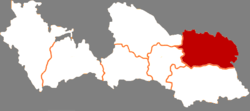Jingchuan County
Jingchuan County (simplified Chinese: 泾川县; traditional Chinese: 涇川縣; pinyin: Jīngchuān Xiàn) is county under jurisdiction of the prefecture-level city of Pingliang, in the east of Gansu Province, China, bordering Shaanxi Province to the southeast. It has a land area of 1,486 square kilometers, and a population of 330,000 in 2004. The postal code is 744300. The seat of government is Chengguan Town.
Jingchuan County 泾川县 Kingchwan | |
|---|---|
County | |
 Jingchuan in Pingliang | |
.png) Pingliang in Gansu | |
| Coordinates (Jingchuan government): 35°19′58″N 107°22′04″E | |
| Country | People's Republic of China |
| Province | Gansu |
| Prefecture-level city | Pingliang |
| Time zone | UTC+8 (China Standard) |
History

Under the name Jingzhou, Jingchuan was formerly the seat of Gansu's Jing Prefecture.
Administrative divisions
- Towns: Chengguan, Yudu, Gaoping, Libao.
- Townships: Neifeng, Wangcun, Luohandong, Jingming, Honghe, Yaodian, Feiyun, Taiping, Fengtai and Dangyuan.
Education
From 2006 to 2008, after intensive systematic study, Living Knowledge Communities, Northwest Normal University and Jingchuan County Education Bureau have jointly organized a 3-year project called “The Learning School Community in Rural China Project” (LSCiRC). Involving 9 primary and 9 middle schools in Jingchuan County, the LSCiRC aims to help put traditional rural schools on a trajectory of transformation into learning schools. LiKeCom’s long-term goal is to translate the Jingchuan experience into a model for replication in other impoverished communities of rural China so as to speed up rural educational and community development in China. Project experts are invited to organize regular trainings for rural teachers and school principals and administrators, scientific educational action researches, exchange activities and encourage the establishment of pluralist communities of practice to raise the human capacity of the rural community with the application of information and communication technologies.
Transport
External links
- Official website of Jingchuan County
- Learning School Community in Rural China Project